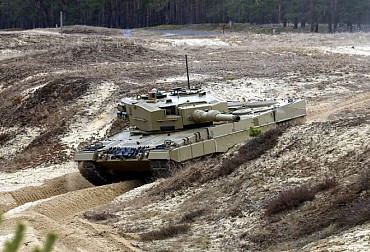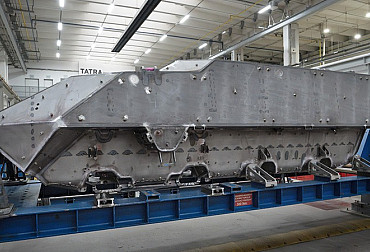U.S. Patriot systems in the Slovak Defence Ministry's spotlight
Slovakia has long struggled with a lack of air defence capability. After donating its only S-300 PMU system and parts of the 2K12 KUB sets to the defending Ukraine, the allies stepped in to protect Slovakia's skies. They temporarily deployed Patriot and SAMP/T Mamba systems on Slovak territory, and Germany then donated two MANTIS air defence systems to Slovakia free of charge. Last September, the Slovak Ministry of Defence selected the Polish Piorun and Israeli Barak MX as suitable systems for building up modern air defence capabilities. The current head of the Ministry of Defence, Robert Kaliňák, recently announced that the Slovak air defence system could also be supplemented by American Patriot systems.

The improvement of air defence has been a much discussed topic in recent months in connection with the modernisation of the Armed Forces of the Slovak Republic (AF SR). Since the establishment of the independent Slovak Republic, the Slovak Armed Forces have relied on Soviet-origin S-300 PMU, 2K12 Kub and 9K38 Igla portable air defence systems. However, after the invasion of Ukraine by Russian troops, the then leadership of the Ministry of Defence and the Slovak government itself decided to donate both the S-300 PMU long-range anti-aircraft system and part of the 2K12 Kub systems to the invaded country, which further reduced the capabilities of the Slovak Armed Forces in the field of air defence and forced Slovakia to turn to its allies within the North Atlantic Alliance. The Netherlands, Germany and the USA temporarily deployed Patriot systems on the territory of Slovakia in spring 2022, but these were withdrawn last year. Italy also contributed to Slovakia's defence by installing the SAMP/T Mamba system at the Kuchyně airport last March and Germany donated two MANTIS short-range air defence systems to Slovakia.
In February 2023, the Slovak Ministry of Defence published a feasibility study on the acquisition of air defence systems. As the ministry itself states in the document, the ongoing war in Ukraine has highlighted the need to develop air and missile defence capabilities. It is for this reason that the Slovak defence ministry has presented a plan in the feasibility study on how it intends to proceed in building the necessary air defence capabilities. The acquisition of air defence assets is to be carried out in four stages until 2035, with Slovakia purchasing 36 Polish-made Piorun portable air defence sets and the Israeli Barak MX medium-range air defence system in the first stage.
Reflection on the Patriots
The current head of the Ministry of Defence, Robert Kaliňák, recently told the O 5 minutes 12 discussion programme that in addition to the ongoing negotiations with Israel and Poland, he would like to start negotiations with the United States on the possible acquisition of Patriot systems. To acquire these air defence assets, the defence ministry's leadership would like to use the nearly $700 million that the US has offered to Slovakia for the acquisition of Viper helicopters in compensation for a previous donation of MiG-29 fighter aircraft to Ukraine. Patriot systems are also expected to be part of the European Sky Shield Initiative project.
According to Kaliňák, Slovakia does not need the Viper attack helicopters now, as he believes these machines are the icing on the cake, which Slovakia does not have yet. At the same time, according to the Slovak defence minister, it is necessary to protect not only critical infrastructure, but also civilian objects.
The US-made Patriot systems are among the most widely used air defence systems in the world today, with a maximum range of about 160 kilometres. It is deployed in a total of 18 countries, including the US, Germany, Poland, South Korea, Saudi Arabia and today is also actively involved in the defence of Ukraine's airspace. The latest version of the PAC-3 system features high accuracy and is based on hit-to-kill technology, which means that the target is destroyed by a direct hit rather than by an explosion.
Former Defence Minister Yaroslav Nad has also commented on the possible procurement of Patriot kits. He is convinced that Slovakia should rather accept the US offer for the purchase of Viper helicopters, as it will pay for 12 helicopters from its own funds for approximately 340 million euros and the rest will be financed through the US defence mechanism FMF (Foreign Military Financing). In addition, according to the former defence minister, Slovakia would need at least four Patriot batteries, which it cannot afford. Nad also noted that, depending on the specific type of missiles, the Barak MX kit, whose acquisition was approved by the official government last autumn, has comparable capabilities to the Patriot systems.
Whether the Slovak defence ministry will be able to negotiate a discount on the US Patriot air defence systems will be a matter of at least a few more weeks. What is certain, however, is that the acquisition of these systems would significantly increase Slovakia's capabilities and capacities in the area of air defence and, together with the Piorun and Barak MX complexes, would build a multi-layered air shield. On the other hand, it is necessary to take into account the considerable costs of the system acquisition, the necessary infrastructure development and, last but not least, the possibility of involving the domestic defence industry, which could return part of the potential investment to the state budget.





















